Lazy eye, also known as amblyopia, is a vision condition that commonly affects both children and adults. It occurs when one eye doesn't develop normal visual acuity, leading to reduced vision in that eye. This can result in poor depth perception and overall visual impairment.
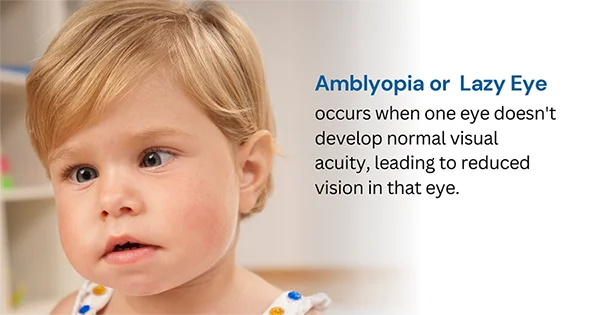
In Delhi, there are specific approaches accessible for lazy eye treatment in both children and adults. You have the option to seek guidance from our top-notch ophthalmologist, who can provide advanced solutions to address this visual concern.
Understanding the Causes
It can stem from various underlying causes, including:
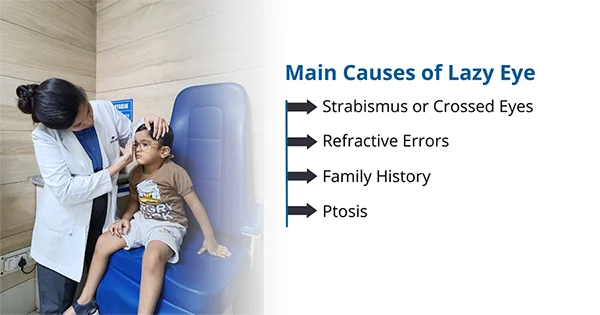
- Strabismus: This condition, commonly known as crossed eyes, occurs when the eyes are misaligned. The brain might suppress the image from one eye to avoid double vision.
- Refractive Errors: Imbalance between nearsightedness, farsightedness or astigmatism of both eyes can lead to this eye problem.
- Family History: If it runs in the family, children might be at a higher risk of developing the same condition.
- Ptosis: Ptosis is the medical term to describe the drooping or sagging of the upper lid, that can be completely or partially obscure the pupil of the eye. Ptosis can affect either one or both eyes and can cause cosmetic and functional issues with the eyes. For children, ptosis may be particularly problematic because it may interfere with the normal development of eyesight.
Identifying the Symptoms
Detecting it early is crucial for successful treatment. Look out for these signs:
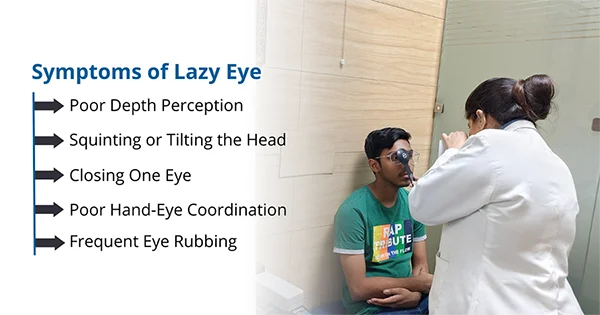
- Poor Depth Perception: Difficulty judging distances and spatial relationships.
- Squinting or Tilting the Head: An attempt to focus better and reduce double vision.
- Closing One Eye: Children might unconsciously close one eye to see better.
- Poor Hand-Eye Coordination: Difficulty catching or throwing objects accurately.
- Frequent Eye Rubbing: An indicator of eye strain or discomfort.
Diagnosing Amblyopia: Early Detection Matters
In the world of vision health, early detection can be the difference between clear sight and enduring challenges.
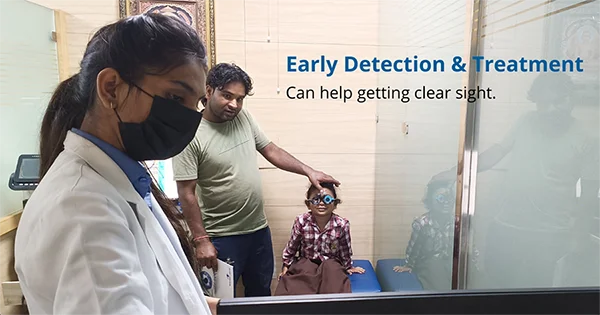
- Timing Is Essential: Children's eyes develop at an astonishingly rapid rate during their development years. Therefore, it is imperative that we detect it early and employ special treatments accordingly as children's brains can change more readily than adult brains can.
- Why Eye Checkups Are Necessary: Scheduling regular eye examinations is key to diagnosing it in children. A thorough exam includes more than simply reading letters on a chart; instead it evaluates how well both eyes line up together, their ability to focus and overall eye health.
- Checking Your Vision: In order to diagnose someone, tests will be run to see how well you see. If one eye doesn't see as well as the other, this could indicate the impairment.
- An Eye Align Analysis: When eyes do not line up correctly, this condition is called "crossed eyes" or "wandering eyes." This can cause Amblyopia, so doctors perform tests to make sure both eyes are looking in the same direction.
- Checking Glasses: If you need glasses, they can make sure both eyes have identical prescriptions to make your vision better. This helps improve how well both eyes can see together.
- Examining Inside Your Eyes: Your doctor will also perform an in-depth inspection to make sure your eyes are in optimal health, so they can identify any conditions such as cataracts that could impair vision and potentially create difficulty for you.
- Beginning Early: Early identification and treatment are crucial in order to effectively combat it. Since brain development can accelerate at an incredible rate in children, wearing an eye patch or participating in special eye exercises may work wonders in improving vision problems.
The journey to understand it continues with the knowledge that early detection serves as a beacon of hope. Armed with insights into the diagnostic process, you're equipped to take proactive steps toward healthier vision.
Lazy Eye Treatment in Delhi: From Patches to Surgeries
Treating this, is like putting together a puzzle with different pieces that fit each person's needs. The main goal of the treatment is to help the weaker eye see better and to make both eyes work well together.
Save Sight Centre, a renowned eye hospital that provides customized Lazy Eye treatment in Delhi. Our team guides and educates the patient about the exercises and its uses. It helps the patient to focus in a better way. The following are some exercises that we guide the patient.
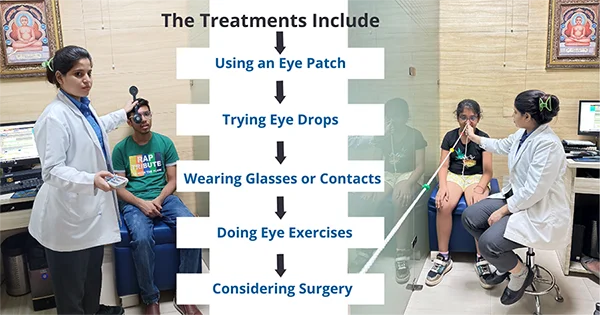
- Using an Eye Patch: One way to treat it is by wearing an eye patch over the stronger eye. This makes the brain use the weaker eye more, which helps it get better at seeing things.
- Trying Eye Drops: Instead of a patch, special eye drops can be used. These drops make the stronger eye a bit blurry, so the brain has to use the weaker eye more. This helps the weaker eye get stronger.
- Wearing Glasses or Contacts: Sometimes, glasses or contact lenses can help fix vision problems that cause this eye problem. These make sure both eyes can see clearly.
- Doing Eye Exercises: Doing exercises for the eyes, like games and activities, can help the weaker eye get stronger. A professional like Optometrists at Save Sight Centre, can guide you through these exercises.
- Considering Surgery: If it is really serious or there are problems with the eyes' structure and misalignment (squint), surgery might be an option. The surgery can fix things like eyes that don't line up correctly or cataracts that affect vision.
- Family Support Matters: For kids getting the treatment, having support from their family is really important. Encouragement, being patient, and following the treatment plan all help make the treatment work better and the experience smoother.
Beyond the Eyes: Emotional and Psychological Impact
It goes beyond just how well we see things – it can also affect how we feel inside and how we interact with others.
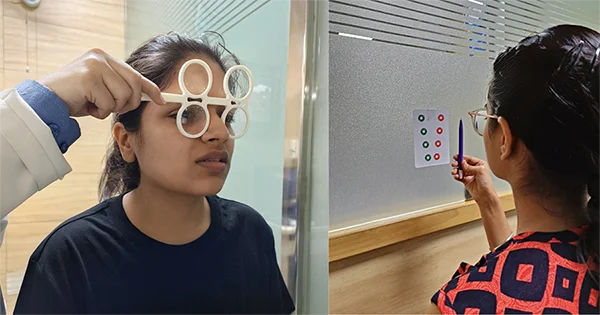
- Hidden Struggles: Dealing it, can be tough in ways that aren't obvious. Kids and grown-ups who have this problem might face emotional challenges that we need to pay attention to.
- Feeling Good About Ourselves: Kids might see themselves differently because of how their eyes look or work. This can affect how they feel about themselves and how confident they are, sometimes making them feel like they're not good enough.
- Making Friends: It can also change how we act around others, especially in kids. They might worry about looking different and might not want to join activities or talk to new people.
- Doing Well in School: For kids, It can make school a bit harder. It might be tough to see what the teacher writes on the board or understand what's in books or worksheets.
- Dealing with Challenges: Both kids and adults find ways to deal with the challenges that this impairment brings. Some might avoid looking at people's eyes, while others might use humour to protect themselves.
- Help from Family: Parents are super important in helping kids feel better emotionally. Talking openly, being understanding, and giving lots of support can help kids share their feelings.
- Getting Professional Help: Sometimes, the emotional struggles are big, and that's okay. Talking to a professional like a psychologist or counselor can help kids and grown-ups figure out ways to feel better and handle their emotions.
Dispelling Myths: Facts You Must Know
In a world where information can be both enlightening and misleading, it's essential to dispel myths surrounding this eye problem.
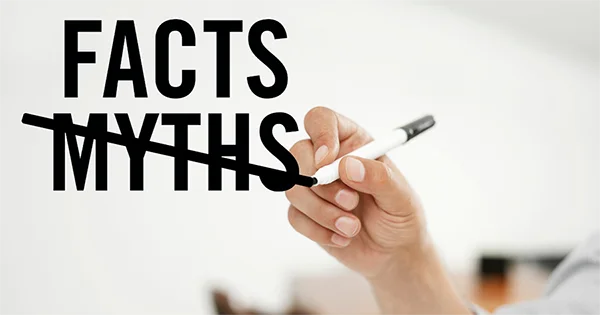
- Myth: It Is Always Inherited Contrary to popular belief, It is not solely a hereditary condition. While genetics can play a role, factors like refractive errors and eye misalignment can also contribute.
- Myth: It Only Affects Children It often emerges during childhood, it can also affect adults. It's presence might go undetected until later in life, impacting visual acuity and quality.
- Myth: It Can't Be Treated After Childhood Adults facing this vision impairment can benefit from treatment. While the brain's plasticity diminishes with age, improvements in visual acuity and binocular vision are still attainable.
- Myth: Patching Therapy Is the Sole Treatment Patching therapy is a common treatment, but it's not the only option. Atropine eye drops, corrective lenses, and vision therapy also contribute to treat it.
- Myth: It Is Always Visible This impairment isn't always physically apparent. While some cases involve noticeable eye misalignment, others might not exhibit overt signs.
- Myth: It Resolves on Its Own It rarely resolves without intervention. Early detection and appropriate treatment are essential to fostering visual improvement.
- Myth: Vision Therapy Is Ineffective Vision therapy, when conducted under professional guidance, can yield positive outcomes. It enhances visual coordination and strengthens the weaker eye.
- Myth: It Is a Minor Issue It can have far-reaching effects on quality of life, from self-esteem challenges to academic performance setbacks. Addressing it is crucial for overall well-being.
- Myth: Only Medical Professionals Can Help While medical professionals play a significant role, individuals and parents can contribute too. Early detection, adherence to treatment plans, and fostering a supportive environment are vital.
Seeing Clearly: Visual Exercises for Amblyopia
By incorporating these activities into the treatment plan, you're actively working toward clearer vision and improved eye health.
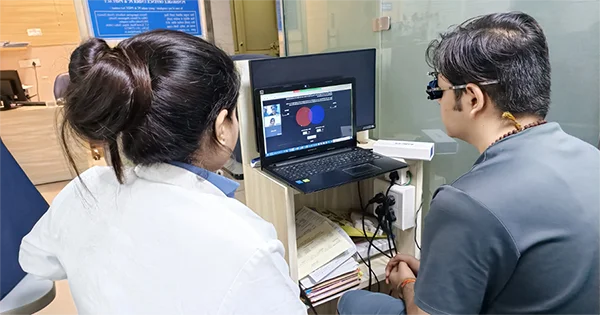
- Eye-Tracking Games: These exercises involve following moving targets with your eyes. Doing this helps both of them work more harmoniously together, so both stronger and weaker eyes work cooperatively.
- Improve Your Ability to See Light and Dark: Some exercises challenge your eyes' ability to differentiate between light and dark, making your vision better at understanding what's being seen in front of them. These activities could improve how quickly and clearly they comprehend what they're seeing.
- Looking Beyond the Center: When practicing looking beyond just in front of you, this exercise helps increase awareness of what's around you and can be especially useful for people living with this impairment.
- Activities to See in 3D: These exercises help your eyes learn to combine images from both eyes into three dimensional scenes that appear just like they would appear in real life. This allows them to perceive objects more realistically.
Remember, these exercises require your patience and persistence; by practicing regularly alongside other treatments, your vision should improve over time.
Frequently Asked Questions (FAQs)
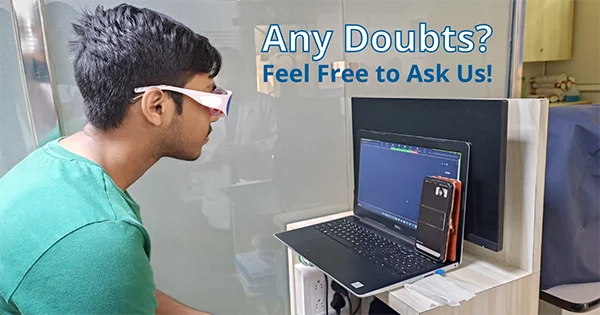 FAQ 1: Can it be treated in adults?
FAQ 1: Can it be treated in adults?
Yes, it can be treated in adults, although treatment might take longer and results may vary compared to treatment in children.
FAQ 2: Is it only caused by refractive errors?
No, it can also be caused by factors like strabismus (misalignment of the eyes) or a combination of refractive errors and eye misalignment.
FAQ 3: Can it resolve on its own?
It rarely resolves on its own. Early detection and appropriate treatment are essential for improvement.
FAQ 4: Are vision exercises effective in treating it?
Yes, vision exercises can be effective in treating it, especially when done under the guidance of an eye care professional.
FAQ 5: Can adults benefit from its treatment?
Yes, adults can benefit from its treatment, although improvements might be more modest due to reduced







 FAQ 1: Can it be treated in adults?
FAQ 1: Can it be treated in adults?